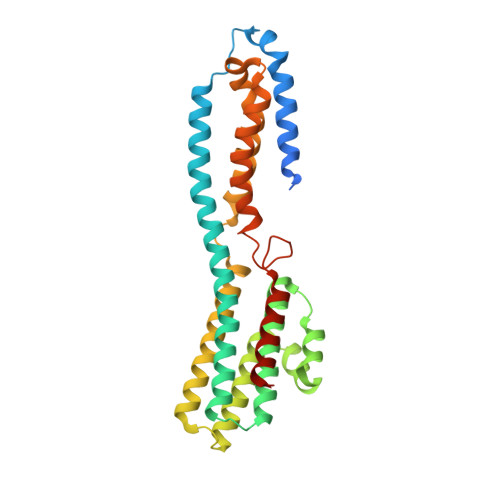Dual Ca2+-dependent gates in human Bestrophin1 underlie disease-causing mechanisms of gain-of-function mutations.
Ji, C., Kittredge, A., Hopiavuori, A., Ward, N., Chen, S., Fukuda, Y., Zhang, Y., Yang, T.(2019) Commun Biol 2: 240-240
- PubMed: 31263784
- DOI: https://doi.org/10.1038/s42003-019-0433-3
- Primary Citation of Related Structures:
6IV0, 6IV1, 6IV2, 6IV3, 6IV4, 6IVJ, 6IVK, 6IVL, 6IVM, 6IVN, 6IVO, 6IVP, 6IVQ, 6IVR, 6IVW, 6JLF - PubMed Abstract:
Mutations of human BEST1 , encoding a Ca 2+ -activated Cl - channel (hBest1), cause macular degenerative disorders. Best1 homolog structures reveal an evolutionarily conserved channel architecture highlighted by two landmark restrictions (named the "neck" and "aperture", respectively) in the ion conducting pathway, suggesting a unique dual-switch gating mechanism, which, however, has not been characterized well. Using patch clamp and crystallography, we demonstrate that both the neck and aperture in hBest1 are Ca 2+ -dependent gates essential for preventing channel leakage resulting from Ca 2+ -independent, spontaneous gate opening. Importantly, three patient-derived mutations (D203A, I205T and Y236C) lead to Ca 2+ -independent leakage and elevated Ca 2+ -dependent anion currents due to enhanced opening of the gates. Moreover, we identify a network of residues critically involved in gate operation. Together, our results suggest an indispensable role of the neck and aperture of hBest1 for channel gating, and uncover disease-causing mechanisms of hBest1 gain-of-function mutations.
Organizational Affiliation:
Department of Pharmacology and Physiology, University of Rochester, School of Medicine and Dentistry, Rochester, NY 14642 USA.















